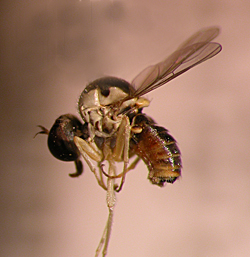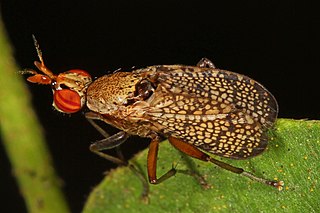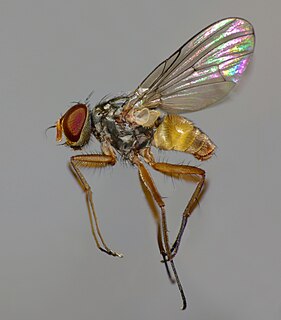
The Ulidiidae or picture-winged flies are a large and diverse cosmopolitan family of flies (Diptera), and as in related families, most species are herbivorous or detritivore. They are often known as picture-winged flies, along with members of other families in the superfamily Tephritoidea that have patterns of bands or spots on the wings. Some species share with the Tephritidae an unusual elongated posteroapical projection of the anal cell in the wing, but can be differentiated by the smoothly curving subcostal vein. Two species, Tetanops myopaeformis and Euxesta stigmatias, are agricultural pests.

The Lauxaniidae are a family of acalyptrate flies. They generally are small flies with large compound eyes that often are brightly coloured in life, sometimes with characteristic horizontal stripes, such as in Cestrotus species. Many species have variegated patterns on their wings, but in contrast they generally do not have variegated bodies, except for genera such as Cestrotus, whose camouflage mimics lichens or the texture of granitic rocks.

Mythicomyiidae, commonly called mythicomyiids, are very tiny flies (0.5–5.0 mm) found throughout most parts of the world, especially desert and semi-desert regions, except the highest altitudes and latitudes. They are not as common in the tropics, but genera such as Cephalodromia and Platypygus are known from these regions. Many of these "microbombyliids" have a humpbacked thorax and lack the dense vestiture common in the Bombyliidae. Mythicomyiids have until recently not had much attention in the literature. Their small size has caused them to be missed when collecting. Yellow pan trapping and fine-mesh netting in Malaise and aerial sweep nets has resulted in a number of undescribed species from many parts of the world. A high diversity of both genera and species exists for this family in Africa, especially northern and southern portions. About 350 species are known. Hundreds more await description.

Campsicnemus is a genus of flies in family Dolichopodidae. There are more than 290 described species, made up of 34 Palearctic, 22 Nearctic, seven Afrotropic, 170 Australasian and Oceanian, and seven Indomalayan species. Some species endemic to the Hawaiian islands are characterized by their lack of wings. After the introduction of invasive ants and other alien species such as wild boar (Sus scrofa) to the islands, some of these flightless species are believed extinct.

Ceromya is a genus of tachinid flies in the family Tachinidae, containing the following species:
Neotachina is a genus of tachinid flies in the family Tachinidae. The four known species in this genus were collected in New Zealand in 1938 and described by Scottish entomologist John Russell Malloch.
Peribaea is a genus of flies in the family Tachinidae.

Senostoma is a genus of parasitoid tachinid flies in the family Tachinidae. Endemic to Australasia, the flies are medium-sized, bristly, and long-legged.
Neoeuxesta fumicosta is a species of ulidiid, or picture-winged, fly in the genus Neoeuxesta; it is found in Samoa.
Neoeuxesta guamana is a species of ulidiid, or picture-winged fly, in the genus Neoeuxesta. It is found in Guam.

Actia is a genus of large flies in the family Tachinidae.

The Helosciomyzidae are a small family of flies - 9 genera and 22 species. All are known from the Southern Hemisphere. With the exception of the South American genus Sciogriphoneura, the family occurs in Australia, New Zealand. Little is known of their biology.

Platystomatinae is a subfamily of flies (Diptera) in the family Platystomatidae that includes 80 genera, the largest subfamily with at last estimate, c. 900 species globally.

Sympycninae is a subfamily of flies in the family Dolichopodidae.

Tetanocerini is a tribe of flies in the family Sciomyzidae. There are at least 120 described species in the tribe.

Sciomyzinae is a subfamily of flies in the family Sciomyzidae.

Spilogona latimana is a fly from the family Muscidae. It is found in New Zealand.

Limnohelina bivittata is a fly from the family Muscidae. It is found in New Zealand.
Homalocnemis is a genus of flies which is placed in a family of its own, the Homalocnemiidae. There are about seven species in the genus found in the Afrotropical, Neotropical, and Australasian regions, suggestive of a Gondwanan origin. The genus was formerly considered a primitive empidoid and placed variously in the Hybotidae or in the empidid subfamily Brachystomatinae. They are recognized by their wing venation which includes a long anal cell and a long basal segment of the antennal style.












